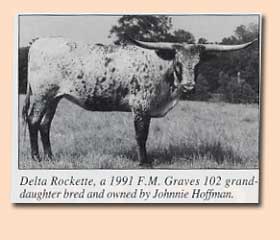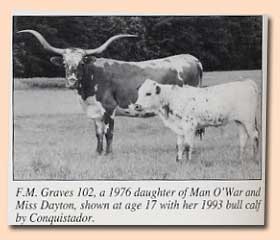Reprinted from the Texas Longhorn Journal, July/August 1993
The study of the Texas longhorn bloodlines is one of the most fascinating aspects of raising this breed of cattle. The names of the people whose efforts to save the Longhorn from extinction while unknowingly creating the "Seven Families" of Texas Longhorns are legendary: Milby Butler, Emil Marks, Graves Peeler, Jack Phillips, John Hatton and Will Barnes, M.P. Wright II, and Cap Yates.
In this exclusive two-part TLJ feature, long-time owners and producers of these different families (along with what is sometimes called the "eighth family," the U.S. herd of Nebraska's Fort Niobrara National Wildlife Refuge, present, in their own words, overviews of each family and its impact on today's Texas Longhorn industry. Part I looks at the Butler, Phillips, Wichita Refuge (WR) and Yates families.
Today's Butler Bloodline: Better than Ever
By Kaso Kety, Ace Cattle Company, Folsom, Louisiana
 The Butler bloodline, one of the most popular and profitable of the "Seven Families," has it's roots on the Butler Ranch at League City, Texas. While the bloodline is more associated with Milby Butler, it was actually his son, Henry, who started the herd. Henry's foundation cattle were those he received working as a hand during the roundups between Houston and Galveston, Texas. Henry always took his pay in heifers and always chose the biggest horned ones. Their origin was "just old big horned Texas cattle."
The Butler bloodline, one of the most popular and profitable of the "Seven Families," has it's roots on the Butler Ranch at League City, Texas. While the bloodline is more associated with Milby Butler, it was actually his son, Henry, who started the herd. Henry's foundation cattle were those he received working as a hand during the roundups between Houston and Galveston, Texas. Henry always took his pay in heifers and always chose the biggest horned ones. Their origin was "just old big horned Texas cattle."
The Butlers also ran an extensive stock pen and slaughterhouse business. The best cattle were sifted over the years and added to the growing Texas Longhorn herd. In 1923, Milby separated the Longhorns from the rest of the cattle and while he was interested in preserving the native Longhorns, it was not until Henry was away in the service during WWII that Milby took over full responsibility for the ranch's Longhorn breeding program.
No one will argue with the fact that Milby bred for horns. His cattle were carefully selected and put with bulls he thought would produce length, base, and corkscrew shape in the horns of their offspring.
Milby was very reluctant to part with any of his Longhorns and only in a few cases did he release any of his prized genetics. Some of the cattle were part of Milby's wife's estate and were sold upon her death a year or two before Milby's passing. Immediately following Milby's death (October 16, 1971) virtually all the remaining cattle were sold at auction.

Approximately eighty percent went to slaughter; the other twenty percent were purchased by Longhorn breeders fortunate enough to learn of the sales. Twenty of the best Butler cattle were kept by Milby's secretary, Pauline Russell, which she eventually sold in 1977, keeping only the legendary cow Beauty at that time.
It is only chance that any survived at all. Through the efforts of a few breeders, a precious number of the cattle were saved. These small herds were line-bred with each becoming a closed genetic pool. It is generally accepted that there are seven separate Butler lines as well as straight Butler cattle used in other herds (outcross) that do not fall into these established programs. A listing of those distinct "Butler" lines and a partial list of three or four of the most well known and influential bulls and cows from each is as follows:
 The Partlow Family of Liberty, Texas
The Partlow Family of Liberty, Texas
Conquistador, Colorado Cowboy, Dode's Boy, Conquistaroan, Rose Red, Maressa, Princess 2/7, Alicia of '83
Blackie Graves of Dayton, Texas
Sam, Man O'War, Classic, Monarch, FM Graves 54, Graves 68, FM Graves 102, Classey Nicole.
Michael McLeod of Vanderbilt, Texas (Lepper Bloodline)
Thomas, Pappy "L", He's a Ten, Royal Ten
Dewitt Meshell of Trinity, Texas
Little OT, Droophorns, White Horns 68, MF Droopy, MF Dynamite.
Luman Holman of Jacksonville, Texas
Holman B1, Holman B3, El Patron, Holman Cow 1, Holman Cow 3, Holman 6
Ruel Sanders of Magnolia, Texas
Bevo, Bimbo, Jumbo Horns, White Lace Miss Magnolia, Easter
Virgil Shinn of Idaho Falls, Idaho
Elmer, White Milby, Red Milby
The future is brighter than ever before for the Butler Bloodline as modern day breeders are using different combinations of cattle from these established "lines" to produce today's Butler Longhorns. When these distinct Butler gene pools have been crossed, resulting offspring have shown the size, color, and outstanding horn growth of the original Butler herd.
Butler Longhorns are unique in several ways. The primary difference is a geographical one. These east Texas / Gulf Coast cattle evolved to fill a niche much different from their brethren living on the plains and desert to the north and west. The Butler breeding program went far beyond horns. It was an effort to reproduce a specific type of Longhorn. It seems that Milby was not content to simply preserve the breed, but had a desire to duplicate the purist and most outstanding examples of it. The Butler cattle also possess several unique skeletal differences including topline, tailhead attachment, and "crocodile eyes". Additionally there are several color patterns found only in the Butler cattle. TLBAA registration inspector Garnett Brooks visited the Butler ranch during the mid-1960s and recalled, "again we saw the identical type of twisted big-horned cattle. The cattle were very uniform. They were selected for a specific type of [Milby's] own desire. He felt he had a true type of the Old Blood.: While the Butlers are quite unique, they excel in all traits Longhorn and are first and foremost performance cattle. They are Longhorns right down to their hairy ears, "foxtail" switches and Texas Twist horns, maybe even more so.
While the Butler Bloodline is best known for extraordinary horn growth, Butler cattle offer much, much more. They are true Texas Longhorns in every sense, not just the obvious.